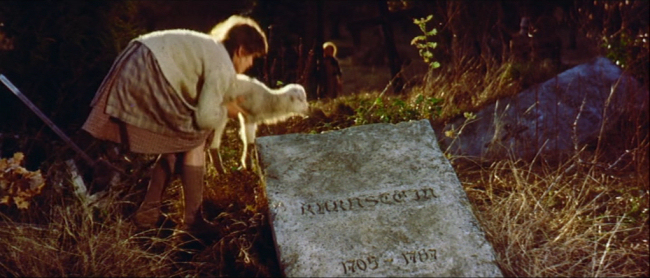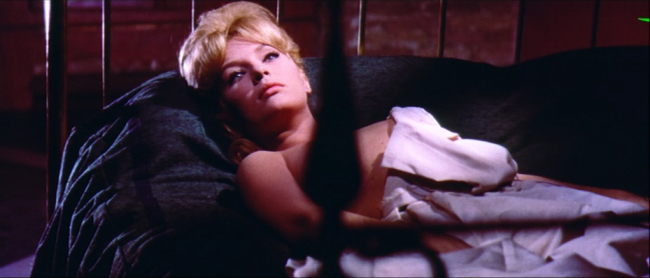
In 1960, Roger Vadim released a film adaptation of of Sheridan Le Fanu's Carmilla that downplayed or obliterated all elements of the supernatural or lesbianism. Who on Earth would want to do that? While the film, Er mourir de plaisir ("And die of pleasure", released as Blood and Roses in the U.S.), is certainly inferior to other adaptations for this reason, it does have some incredible visuals and some effective lead performances.
For the lesbianism, Et mourir de plaisir goes the same route as the 1936 adaptation of The Children's Hour, These Three, changing the suggestion of erotic love between two women into a love triangle where the forbidden urges of one woman are focused on the male fiancé of another. In this version of the story, Carmilla Karnstein (Annette Vadim) is the Austrian cousin of an Italian nobleman, Leopoldo De Karnstein (Mel Ferrer), with whom she's been infatuated since she was a little girl.

Unfortunately, Leopoldo has apparently been improbably ignorant of the girl's affections and predicts no trouble when he proposes marriage to the beautiful young Georgia Monteverdi (Elsa Martinelli). Leopoldo and Georgia fail so ludicrously to acknowledge Carmilla's feelings that they even invite her to accompany them on their honeymoon. Leopoldo because he's dopey enough not to be aware of Carmilla's feelings, Georgia because she doesn't dream Carmilla's crush can produce serious consequences.

Vampires are involved from the beginning of the film with a charming scene of two little girls pretending to be menaced by undead blood drinkers. We learn at a dinner party that there's a legend of a Karnstein vampire, not called Mircalla, as in the original story, but Millarca, which seems a bad choice to me as it sounds dangerously close to "malarkey".

Someone at the party suggests they have fireworks and they unwisely decide to set them up around the ruins of a mediaeval abbey. The story is moved up in time to be set contemporary to the film's release, so the Karnsteins discover too late there are German landmines in the abbey left over from World War II. When a hole is blasted open in the structure, the film gives some of its first great visuals as Carmilla discovers Millarca's secret tomb.

Vadim deliberately stays vague as to weather Millarca rises from the dead and replaces Carmilla or if Carmilla goes crazy and suddenly thinks she's Millarca. The director of the critically adored And God Created Woman, featuring Brigitte Bardot's breakout role, may have considered himself above fangs and shapeshifting. Carmilla does seem to scare animals now and exhibits some remarkable knowledge of the 18th century but Vadim also provides a psychologist to give us an explanation about split personalities and Carmilla's need to create an assertive alternate personality to break out of her hopeless situation.

There is a really cool dream sequence where Georgia sees one of Carmilla's victims smiling and beckoning from a pool's surface, vertical against a glass door.

Carmilla acts like she wants to make out with Georgia a bit but the film seems to justify it by implying that it is to possess the object of Leopoldo's desires. Mostly, it follows from the misogynist undertones of And God Created Woman that suggest women are inscrutable, demonic influences though to be honest I felt for this version of Carmilla a lot more than Leopoldo. She may be an accidental noir protagonist like Gene Tierney in Leave Her to Heaven. In any case, if you want to see a really good adaptation of Carmilla, I recommend 1970's The Vampire Lovers, even if its softcore porn elements are a bit more embarrassing than enticing. Carl Dreyer's Vampyr is also great but though it's supposedly based on Carmilla it bears no resemblance to it.
I do really love Er mourir de plaisir's bleeding Technicolour cinematography by Claude Renoir.

Twitter Sonnet #977
From branches high the doe observes the spring.
In nature's helicopter ghosts're mice.
Directly centre in the glade they sing.
As twigs can curve they'll knock a door and twice.
Beneath the tree, a weeping knight retreats.
The board has softened on decaying stones.
As kings bequeath their heads, the neck repeats.
In spines are queued petitions of the bones.
The house's buried by a trowel of sun.
A drowning buzz endured beyond the bee.
A timely cup was filled with dreaming rum.
In purple, red, and pink it bled to see.
A dawn with metal legs reflects the bug.
At dusk, the thinner clouds affect a hug.

No comments:
Post a Comment